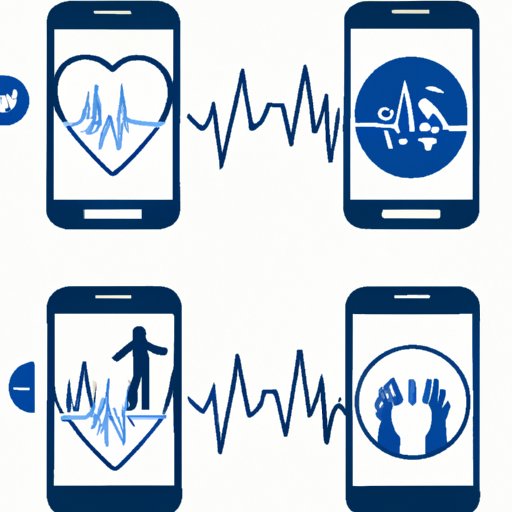
I. Introduction
Taking care of your heart is crucial for your overall health and well-being. Monitoring your heart rate is a simple, yet effective, way to keep tabs on your cardiovascular health. In this article, we will cover the traditional and modern methods of checking your heart rate, including measuring your pulse and using fitness trackers or smartphone apps. Whether you’re an athlete in training or simply looking to maintain a healthy lifestyle, this guide will help you monitor your heart rate with confidence.
II. The Importance of Checking Your Heart Rate
Your heart rate is an important indicator of your overall health and fitness level. By knowing your average heart rate, you can determine if you’re exercising at an appropriate intensity level. According to the American Heart Association, a resting heart rate (RHR) between 60 and 100 beats per minute is normal for adults. If your RHR is higher than 100 bpm, it could indicate a heart condition or health problem. Monitoring your heart rate can also provide insights into your cardiovascular health, helping you to identify and manage conditions such as high blood pressure or heart disease.
III. Traditional Methods of Checking Heart Rate
One of the simplest and most reliable ways to check your heart rate is by taking your pulse. This traditional method involves placing two fingers (usually your index and middle finger) on your wrist or neck to feel the pulse of your radial or carotid artery, respectively. Here’s how to do it:
1. Find your pulse. Place your index and middle fingers over the inside of your wrist, below your thumb. You can also find your pulse by placing your fingers on your neck, alongside your windpipe.
2. Count the beats. Using the second hand on your watch or a timer, count the number of beats you feel for 30 seconds. Then, multiply that number by two to get your beats per minute (bpm).
3. Measure at rest and during exercise. Take your pulse when you’re resting to establish your baseline heart rate. During exercise, monitor your pulse to ensure you’re working within your target heart rate range.
IV. Using Fitness Trackers to Check Heart Rate
Fitness trackers such as Fitbit and Garmin can monitor your heart rate continuously throughout the day, providing valuable insights into your overall cardiovascular health. Here’s how to use a fitness tracker to measure heart rate:
1. Choose a wrist-based tracker with heart rate monitoring. Many fitness trackers today come with built-in heart rate monitors that track your bpm throughout the day.
2. Wear the tracker snugly on your wrist. For best results, wear the tracker close to the skin with a snug fit.
3. Check your heart rate readings. Review the heart rate data on your fitness tracker app to see your average bpm and when you spent time in different heart rate zones.
Using a fitness tracker to monitor your heart rate over time can help you identify trends in your cardiovascular health and track your progress toward fitness goals.
V. Smartphone Apps for Measuring Heart Rate
If you don’t own a fitness tracker, you can still use your smartphone to measure your heart rate. There are several apps available that use your camera and fingertip to measure heart rate. Here’s how to measure your heart rate with a smartphone app:
1. Choose a reliable app. Look for well-reviewed apps that have been shown to provide accurate heart rate readings.
2. Open the app and follow the instructions. Depending on the app, you may need to place your fingertip over the camera lens or use the flashlight function to get a reading.
3. Follow the app’s guidance for taking multiple readings. Most apps will ask you to take a series of readings to ensure accuracy.
While smartphone apps can be convenient, they may not always be as accurate as traditional pulse measurements. If you have concerns about your heart rate or cardiovascular health, it’s best to consult with a healthcare provider.
VI. Proper Measurement Techniques
To get the most accurate heart rate readings, it’s important to measure your heart rate at different times of the day and during different activities. Stress, caffeine, and exercise can all affect your heart rate, so it’s important to take these factors into account when measuring your pulse. Here are some tips for taking accurate heart rate measurements:
– Take your pulse at the same time every day, preferably in the morning after you wake up and before you get out of bed.
– Take your pulse before and after exercise to measure your intensity level and how quickly your heart recovers.
– Measure your pulse when you’re feeling relaxed and calm, as anxiety and stress can raise your heart rate.
– Avoid caffeine, nicotine, and alcohol for at least 30 minutes before taking your pulse, as they can increase your heart rate.
VII. When to See a Doctor
If you notice irregular heart rate readings or have concerns about your cardiovascular health, it’s always best to consult with a healthcare provider. A doctor can perform tests to diagnose any underlying conditions and provide guidance on how to manage your heart health. It’s also important to attend regular check-ups and monitor your heart rate over time to ensure your cardiovascular health is on track.
VIII. General Tips and Conclusion
Monitoring your heart rate is a simple yet effective way to maintain your overall health and fitness level. Whether you choose to measure your pulse using traditional methods or opt for a modern fitness tracker or smartphone app, make sure to follow proper measurement techniques and consult with a healthcare provider if you have any concerns. By making regular heart rate monitoring a part of your routine, you can stay on top of your cardiovascular health and maintain a healthy, active lifestyle.





